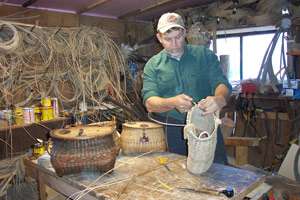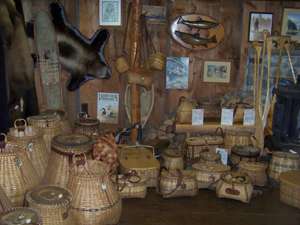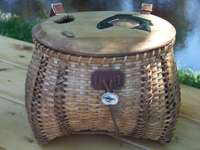Bill Mackowski’s stick-built house and rustic outbuildings in Milford, Maine, taken as a whole, suggest a frontier settlement more than a modern, private residence. Antique tools, fishing tackle, and North Woods memorabilia line the front porch, a hint to the first-time visitor of what to expect inside.
Mackowski, tall, gaunt, and wearing a two-day beard, lifts the metal latch on the front door and extends a rough hand. Inside, the soft-spoken craftsman offers his guests a mug of “camp coffee,” made on the stove in an old-fashioned enamel coffeepot, in the time-honored tradition of the woods. Evidence of Mackowski’s devotion to his craft occupies every nook and corner of his living room. Instead of magazines and coffee table books, his end tables hold hand-made tools, knives, clamps, and other tools of the basketmaker’s trade.
Brown ash baskets and custom-made, brown-ash fishing creels are Mackowski’s specialty. He began making baskets seriously in the early 1980s and today produces 40–50 pack baskets and 25 or 30 creels a year. He sells most of his pack baskets right out of his shop; the advertising is all done by word of mouth. He also makes limited-edition baskets that are available through the Orvis Company.
A Mackowski pack basket is a functional work of art. He offers five styles of working packs and several limited edition, collectable packs with unique flares. Some of the fancier models feature lure pouches that are woven right into the pack structure. A special commemorative trapper’s pack features a carved wooden top affixed to the basket with a deer-hide webbing known as babiche.
His traditional fishing creels exhibit similar artistic flourishes and have become favorites of collectors. These exhibit perfectly the styles and long-past trends in creel making. Some creels look much like the archetypal version seen in old-time fishing magazines. Others, such as an Abenaki onion
creel, shaped like an onion, exhibit considerable flair.
Mackowski’s interest in basketmaking is an extension of a life spent outdoors. Born in rural western Pennsylvania, he began trapping at age seven. Thirty five years ago, he relocated to Northern Maine, where he found work as a Maine guide, trapper, and bush pilot, among other things. He studied wildlife biology and hired on for contract work with the FieldW ork Maine Department of Inland Fisheries and Wildlife studying coyote dispersion and white-tailed deer populations. He’s traveled extensively throughout the Northeast and northern Canada, from Labrador to the Yukon, Minnesota to the Gaspé of Quebec.
In his travels, Mackowski has been fortunate enough to meet and get to know a number of fine woodsman, who all seemed to have one thing in common: pack baskets. These are the precursors to today’s backpacks.
“For hundreds of years, no self-respecting Maine woodsman left camp without a pack basket,” said Mackowski. Another backwoods staple is the creels, a basket slung over the shoulder and made to carry brook trout and keep them cool and fresh. Nobody ever carried trout on a stick, as so often portrayed on calendar pictures. The fish, exposed to sun and air, would dry out and become tainted. Creels were, and are, a virtual necessity. Those old-time woodsmen didn’t buy their pack baskets or fishing creels. Instead, they made their own. Many of today’s treasured works of art were once, in fact, utilitarian items born of necessity. What’s more, pack baskets and creels differ in style from region to region, and in the case of indigenous peoples, from nation to nation and tribe to tribe.
Mackowski’s association with and growing interest in pack baskets and creels naturally turned to a desire to make them himself. Fortunately for him, he found willing instructors. While the list of mentors stretches for many lines, he has a special affection for two men in particular: Jack Leadley of Speculator, New York, and Larry Hurd from Bangor, Maine. Mackowski said, “Jack Leadley had more impact on my life than anyone else other than my father.”
His skills grew exponentially under the tutelage of these talented craftsmen, to a point where he became a skilled basketmaker in his own right. “I’m a continuation of what these gifted, older people have taught me,” Mackowski said.
Commercially produced baskets are fashioned from a variety of materials ranging from willow shoots to maple splints. But traditional basketmakers would never consider using anything but brown ash (what Mackowski and most Mainers call brown ash is the species known as black ash elsewhere). This tree attains a height of over 50 feet, has spongy, cork-like bark, and grows on moist, rich land in damp, cool swamps and along brooks and streams.
Brown ash is surprisingly durable. A well-made brown ash basket or creel might well remain useful for a century or more. The same does not apply to other woods or materials.
To reduce an ash log to a splint, basketmakers “pound out” the wood. Native Americans would soak a log for a month or more to soften it up before pounding on it from one end to the other with heavy wooden clubs. The pounding loosened up the individual layers of the tree along its growth rings. The ash “splints” were then pulled off by hand, one at a time. It could take an entire day to pound out a 10-foot log. Europeans took the process a step further, using a froe to split the log into quarters and sometimes eighths, depending upon the beginning diameter. Then, after flattening the pointed edge of the piece with a drawshave, the basketmaker held the piece over a hardwood stump and, extending only an inch or so at a time, pounded it with a metal hammer. This loosened the cells in the wood and the strips separated in the manner of an old-time fan.
Mackowski employs an electric log pounder to do the job for him. This cleverly designed gadget features a metal cradle for holding the log and a large flywheel equipped with swinging hammers. As the wheel turns, the hammers swing out, pounding even the thickest brown ash log to splints in short order.
The pounding device may be new, but the techniques behind it, and the hand craftsmanship that Mackowski brings to his work and to the traditional craft of basketmaking, are timeless. Bill Mackowski’s work can be seen at billmackowskitraditionals.com. He’s always eager to speak with anyone with black ash for sale.





Discussion *